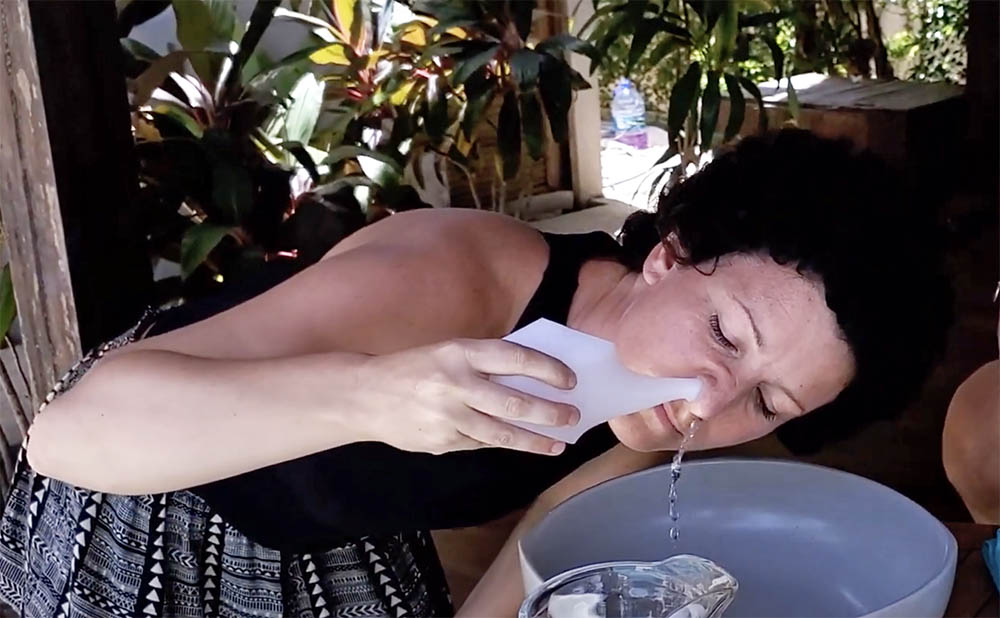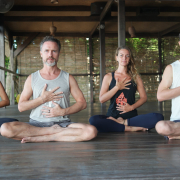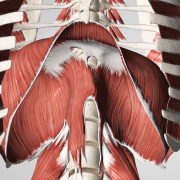 https://samahitaretreat.com/wp-content/uploads/2024/02/basic-breathwork.webp
600
798
Dr. Paul Dallaghan
http://samahitaretreat.com/wp-content/uploads/2024/01/samahita-logo-v2.svg
Dr. Paul Dallaghan2024-02-28 20:34:422024-02-28 20:35:53Navigate the World of Breathing
https://samahitaretreat.com/wp-content/uploads/2024/02/basic-breathwork.webp
600
798
Dr. Paul Dallaghan
http://samahitaretreat.com/wp-content/uploads/2024/01/samahita-logo-v2.svg
Dr. Paul Dallaghan2024-02-28 20:34:422024-02-28 20:35:53Navigate the World of BreathingHow to Train to Breathe Through Your Nose
It’s too easy to take breathing for granted, allowing the respiratory system to do its thing, keeping us alive and functioning, without any conscious effort, day and night. Is your breath pattern supporting your health in the best way it could though?
Unfortunately, many of us learned at a young age to breathe incorrectly, and / or struggled with proper breathing due to asthma, allergies and congestion. Mouth breathing or even very shallow chest breathing through the nose are patterns that when carried into adulthood can cause a host of issues. The good news is that these patterns can be reversed with proper training and attention.
What’s Wrong with Mouth Breathing?
Mouth breathing is, in short, much less efficient. Apart from loss of energy, mouth breathing can cause fairly serious issues in the long term, ranging from snoring and sleep apnea, to bad breath, jaw and teeth issues, gum disease and worsening of asthma symptoms.
The health benefits of nasal breathing, on the other hand, are vast:
- air, temperature and humidity control
- production of immune-boosting nitric oxide (2)
- better quality sleep and less likely to suffer from sleep apnea
- overall more robust lung function
- calmer mental state through activation of the parasympathetic nervous system
Emerging research indicates that nasal breathing might even be better for performance than mouth breathing during exercise (1).
All the benefits of nasal breathing are documented in Proper Breathing is Breathing Through Your Nose, clearly highlighting why this is an important issue to tackle if you are someone that tends to breathe through your mouth. Whether your pattern is constant mouth breathing, occasional gasps through your mouth, or only night time mouth breathing, it is well worth investing the time to discover the cause and to retrain your pattern to nasal breathing, all the time.
“Mouth breathing is, in short, much less efficient. Apart from loss of energy, mouth breathing can cause fairly serious issues in the long term, ranging from snoring and sleep apnea, to bad breath, jaw and teeth issues, gum disease and worsening of asthma symptoms. …..”
What Causes Mouth Breathing?
There are a number of potential causes for mouth breathing including blockages and sinus issues which may be from:
- food sensitivities
- environmental sensitivities
- asthma or allergies
- a deviated septum
More recently mask wearing may cause a feeling of suffocation and make you want to breathe through your mouth – one to watch. However, often mouth breathing is just a habit that was developed at an early age, a pattern that was unconsciously ingrained. Due to respiratory neuroplasticity we now know that we can retrain our breathing patterns, meaning any poor functioning of the respiratory system can be reversed through consistent effort.
Training for Nose Breathing
To be successful in retraining from mouth breathing to nasal breathing you want to:
- Become aware of your breathing patterns
- Deal with blockages & congestion
- Engage in daily breath training
1. Awareness
The first step is to pay attention and become aware of your daily breathing patterns. When you watch your habits, do you notice any of the following?
- Your mouth naturally dropped open during the day
- Gasping for air when talking
- Gasping for air when walking
- Waking up with a dry mouth and blocked nose
- Regularly blocked nostrils
These are all signs that you are in fact a mouth breather, whether regular or only at night. Let’s tackle that situation!
2. Dealing with Blockages and Congestion
Naturally it will be harder to breathe through your nose if it is congested. Here are a number of ways to clear the nasal passages:
A) Neti pot and neti string
Similar to saline solution used for kids, a neti pot uses warm water with some salt poured into the nostrils, and is an excellent way to clear a blocked nose in the morning, or even at night especially after a day in a polluted environment. Check here for clear instructions.
Sutra neti or neti string is another option, a rubber string that is inserted up through one nostril and pulled out through the mouth enabling you to give your nasal passage a good floss. One side of the nose may be more blocked than the other and require a gentler approach and more time, but it should open eventually if done daily.
B) Nasya therapy
Nasya is an Ayurvedic therapy that also helps with clearing congestion in the nasal passages. It uses special herbal oil, with a few drops in each nostril then sniffed up to help clear blockages. It can be done daily after neti pot for added lubrication, as the salt water can be drying, or simply on its own each morning. This is excellent for colder, drier climates.
C) Check eating habits
If you’re finding that you’re congested every day, especially in the morning it is worth checking what food, drink, or general eating habits could be contributing to this. Try avoiding mucus-forming foods such as wheat, dairy, soy, corn and especially processed and fried foods for a while, to see if anything improves. Add bitter greens as well as cruciferous vegetables, garlic, onion and citrus fruits to counteract mucus. Alcohol can also cause inflammation leading to congestion in the sinuses so it’s best to avoid. And always avoid eating late at night, giving yourself at least a few hours between your last meal and sleep so that undigested food is not sitting in the stomach when you go to bed.
D) Check sleeping habits
If your mouth breathing is predominantly at night, signaled by dry mouth in the morning, but you are well able to breathe through your nose during the day, there are a couple of ways you can train yourself to nose breathe at night too:
- Mouth taping:
Use specially designed tape to literally keep your mouth shut at night. Sounds strange but is very effective. Try it and see. - Check sleeping position:
If you sleep on your back and your head is tilted back this will encourage your mouth to drop open. Either change your pillows to give added support to your head so your head is not tilting, or changed your sleeping position to your side.
E) Environment
Mold, damp and pollution can all be contributing factors to congestion of the sinuses. Check for mold in your house and treat it if necessary. Use a dehumidifier in your bedroom if dampness is an issue. And for city dwellers clear your nose out daily at night using a neti pot.
Daily Training
A daily breath training practice will help you not only enhance awareness of your breathing patterns, but also train your breath so that it will eventually, naturally be through your nose for the rest of the day. Gasping for air when walking or talking is essentially hyperventilation, highly stressful on the body, and a sign for the need to slow down, to talk slower, walk slower, relax and to train the breath to a more natural, supportive rhythm.
Start by following the techniques of this relaxed approach, working from savasana to breath training, all while lying down, but with an added focus on breathing through your nose. If your nose is blocked on one side, you can lie for a moment on the opposite side using your arm or a cushion as a pillow.
If this practice becomes easy for you and you wish to advance to a seated breath practice you can follow this 10 minute breathwork practice, again with the focus always on nasal breathing. When sitting, to open up a nostril you can use a small hard cushion directly under the opposite armpit, if needed.
Breathing exercises are also becoming more popular as a natural way to treat asthma (3). I personally trained myself to breathe more through my nose and eventually grew out of my childhood asthma, later starting breathwork and then a daily pranayama practice to strengthen my respiratory function and improve overall health. You can too.
Conclusion
The habit to breathe through your mouth is often developed in childhood when nasal breathing was never fully trained, a huge opportunity missed. It can be reversed as an adult but will take time and awareness. Now especially we all want to support our immune systems to avoid viruses and have the knowledge such as the fact that nitric oxide, which is only produced in nasal breathing, is powerful in supporting immune function and in managing mucus (4). This should be motivation enough. So pay attention, and every time you notice you’re breathing through your mouth, try to close it and switch. Use some of the tips to deal with blockages when needed, and most importantly, start to train your breath pattern daily. Give it time, it may feel difficult initially, but is surely worth the effort to develop a new, healthy, energizing, immune system supporting nasal breathing pattern for the rest of your life.
References
- Jake Panasevich; Nasal Breathing: the Secret to Optimal Fitness?, Health.usnews.com, 2020 https://health.usnews.com/health-news/blogs/eat-run/articles/nasal-breathing-the-secret-to-optimal-fitness
- Jon Lundberg; Nitric Oxide and the Paranasal Sinuses, American Association for Anatomy, 2008
https://anatomypubs.onlinelibrary.wiley.com/doi/full/10.1002/ar.20782 - Mike Thomas, Anne Bruton; Breathing Exercises for Asthma, European Respiratory Journal, 2014
https://breathe.ersjournals.com/content/10/4/312#ref-31 - Jon Lundberg, E Weitzberg; Nasal Nitric Oxide in Man, British Medical Journal, 1999
https://www.ncbi.nlm.nih.gov/pmc/articles/PMC1745376/pdf/v054p00947.pdf
More from the Samahita Blog









